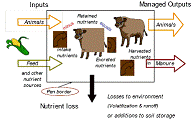Biological Systems Engineering, Department of

Department of Agricultural and Biological Systems Engineering: Presentations and White Papers
Date of this Version
7-2024
Document Type
Presentation
Citation
ASABE Annual International Meeting (Anaheim, California, United States : July 2024): Paper No. 2400159, 13 pages
American Society of Agricultural and Biological Engineers
Abstract
This study delves into the critical role of groundwater in addressing global water challenges, with a focus on the Nubian Sandstone Aquifer System (NSAS) in North Africa. Groundwater constitutes a source of potable water, irrigation, and industrial use, especially in arid regions where surface water is limited. We analyzed the status of water quantity, withdrawals, recharge, and geological characteristics in the NSAS, specifically in Sudan, Egypt, Libya, and Chad. Though the NSAS is largely an untapped resource, we evaluated various scenarios to determine the quantity of cropland that can be sustainably irrigated. The NSAS is located in an arid region, so local recharge does not exceed 10 mm/year. The primary source of recharge comes from the River Nile. The annual recharge is the following: Sudan Platform: 1.44 ± 0.42 km3/yr, Dakhla: 0.135 km3/yr, Kufra: 0.78 ± 0.49 km3/yr. Withdrawal rates are as follows: Egypt: 1.029 km3/yr; Libya: 0.851 km3/yr; Sudan: 0.406 km3/yr; and Chad: 0.001 km3/yr. The amount of water in the (NSAS) in North Africa is estimated at approximately 150,000 km3. This volume is equivalent to about 500 years' worth of the Nile River's discharge. The NSAS is the most extensive fossil aquifer complex globally underlying an area of 2,200,000 km2. The findings contribute valuable insights for policymakers, researchers, and communities grappling with the challenges of groundwater resources to face climate change and water demands.
Included in
African Studies Commons, Bioresource and Agricultural Engineering Commons, Environmental Policy Commons, Fresh Water Studies Commons, Natural Resources Management and Policy Commons, Social Justice Commons, Sustainability Commons, Water Resource Management Commons


Comments
Copyright 2024, ASABE. Used by permission